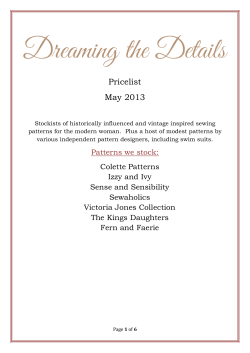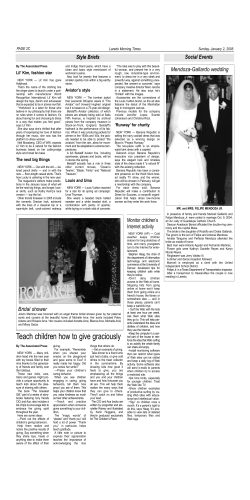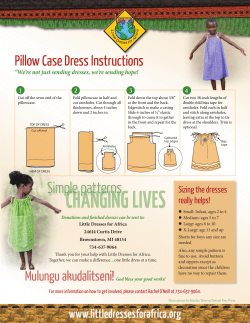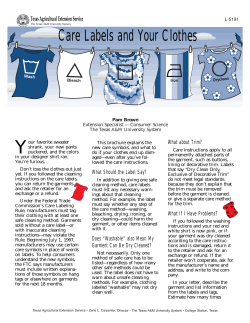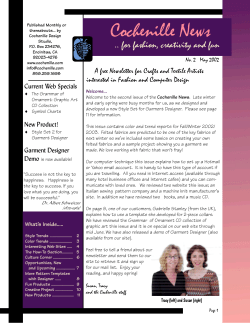
Viking Apron Dress Apron Dress Designs
Viking Apron Dress Ook wel Hangerock (hanging skirt), apron-dress, and Trägerrock (pinafore) Apron Dress Designs http://bjornsson.crosswinds.net/sca/isabel_as/womens-garb/womensgarb.htm From the research I have done, I have found several main apron dress designs that seem to be associated with different locations in the Norse world. When I visited Denmark a couple of years ago, every museum I visited had a different interpretation and therefore a different reconstruction of the women's garments. So we don't have a "right" answer yet. I am still researching this and hope to gain more information as it come available. For now, I have included a possible apron dress design for the major locations in the Norse world. Denmark 9th -10th Century • • • • • • • • I have seen little evidence to support a hanging front apron for 10th century Jutland, though it was done elsewhere (more on that later) Very simple layout and construction Gores are set in the side of the garment Take the bust measurement, add 2 to 4 inches for seams and divide that in two for the width Sew the gores into the sides of the dress Add loops for the brooches The finished garment will produce slightly pointed sides, as seen in the Oseberg tapestry Choose a fine linen or wool for the fabric Sweden This design is the design that you will find on the "Viking Answer Lady's" page. • • • • • • Norway It has archeological support through the study of the loops on the brooches. Recently, a complete female child's grave was uncovered in Gotland that produced a wealth of information and supports this design It helps when you make this design to taper the front hanging part of the apron so it gets wider at the bottom. For the back wrap section measure from nipple to nipple around your back and add 1-2 inches for a seam allowance. For the front hanging apron measure from one side of your breast to the other adding for a seam allowance. Choose a fine linen or wool for the garment and decorate with tablet weaving or embroidery on the front hanging apron. This design is derived from the finds where two sets of loops are found in the brooches. • • • • • • This is another very simple design. It consists of two rectangular panels that are wrapped around the body. (The double wrap apron) Measure around the bust from the front of your armpit to the back of the same armpit and add for seam allowance. Cut two rectangles for this measurement. Add loops to each wrap making sure that the openings are at the sides. It helps to wrap the panels so that if one is on top in the front it is on the bottom in the back. Use fine linen or wool for the apron. Finland: A complete archeological find • • • • • • • • The Finish find is one of the few complete finds for women's garments, along with the children's graves from Gotland. This garment is a peplos held up with brooches with a half apron held on with a belt. First make a peplos as follows. Cut two rectangular peices of cloth that measure 1/2 your bust measurement plus 2-5 inches depending on the fullness that you desire. Sew the sides together 3/4 of the way up the garment leaving room for the overhang in the front and back. Turn the garment right side out and finish the overhang and hem. To this completed peplos, add the apron. The front hanging apron is a simple rectangular piece of cloth, decorated at the hem and attached to a cloth belt. Reconstructed 10th C. Danish Apron Dress http://www.meridies.org/as/dmir/Costume&Fashion/0945.html Garment 1 yard long flared more Bottom can be Wool apron dress with three panels. Rectangular hole at waist indicates use of wool belt (cording or strip of cloth could also be used). Reddish brown and yellow were commonly used colors. Top had a "tuck" here and there to help shape fit. Make the side panel narrower if needed for a better fit. Look for a diamond weave or chevron type weave if you can find them. The shoulder straps and loops can be of cloth or of wool yarn finger weave (very easy -- no loom required). 10th century Danish Apron dress http://www.cs.vassar.edu/~capriest/image/apdress.jpg A Viking Pinafore http://www.gts-ltd.co.uk/shelagh/Hedeby_apron/Hedeby_apron.htm This document is provided as is without any express or implied warranties. While every effort has been taken to ensure the accuracy of the information contained, the author assumes no responsibility for errors or omissions, or for damages resulting from the use of the information contained herein. Permission is granted to make and distribute verbatim copies of this document for noncommercial private research purposes provided the copyright notice and this permission notice are preserved on all copies. Website mirroring is permitted by express prior arrangement. Permission will only be granted if the document is posted in its entirety and the content and format of the document remain completely unaltered by the mirroring site. The definitive version of this document can be found at http://www.shelaghlewins.com. Copyright © 2003 Shelagh Lewins. Introduction The “signature” Viking woman’s garment was a sleeveless overdress worn with a pair of oval or animal-headed brooches. It fastened the dress like the buckles on a dungaree skirt. We don’t know the Old Norse word for it, so it’s referred to by a number of names, including Hangerock (hanging skirt), apron-dress, and Trägerrock (pinafore). The brooches have been found in wealthy women’s graves across most areas of Viking occupation, and are thought only to have been worn with apron-dresses. Although the apron-dress became unfashionable in the later part of the Viking age, it is very popular with re-enactors because it is so clearly Viking, and allows one to wear nice big shiny brooches of bronze, silver or gold-plated bronze. So what was the apron-dress like? Unfortunately archaeological textile finds tend to be few and far between. There are no clear contemporary pictures of the apron-dress. The best preserved find of an apron-dress is from Haithabu (Hedeby harbour), where old garments were used to caulk ships which were subsequently sunk. Hedeby is now in Germany, and is near the Danish border. The finds date from approximately the 10th century AD. Although it is not a complete dress, it tells us a lot about the apron-dress as worn in this particular time and place, and helps to devise a plausible reconstruction. The account of the Hedeby harbour finds has only been published in German [1]. The following article is an annotated summary of Inga Hägg’s report on the Trägerrock. The report was translated by Rachel Kellett, and the summary written by Shelagh Lewins. The notes at the end are additional comments by Shelagh Lewins. Illustrations: Shelagh Lewins, based on those in the original book. Editor: Alexandra "Raven" Fagelson. Thanks to: Lena Strid for assistance with translation and further information. Hägg Pages 38-42 (The fragments) The two fragments from this garment were of fine, repped cloth which had been dyed brown [2]. Figure 1 shows the weave of the cloth. Figure 1: weave The top seam of Fragment A (1 on Figure 2) was made by turning a selvedge over and sewing it down (see Figure 3). There is a hole in the seam with a felted area around it. Both side seams (2 on Figure 2) show regular stitch holes where this fragment was attached to other panels of the garment. A dart runs most of the length of the garment, from 7 cm below the top seam, down to the Fragment B (3 and 4 on Figure 2). Over it is sewn a piece of braid, now 1-2 mm wide, which extends beyond the dart up to the top edge [3]. It is made of six threads, three red and three yellow. This braid has deteriorated considerably, but seems to have been made up of six threads, three red and three yellow. These have been twisted together in pairs and the three strands plaited. See Figure 4 [4]. The dart’s widest point (5 mm) is about 15 cm below the top edge of Fragment A, and at this point there is a hole worn in the cloth. There is a band of felted cloth across the fragment at this point. Fragment B is torn top and bottom, but the sides show the same stitch-holes as on the top piece. There’s no braid on the section of the dart which appears in the lower piece. Figure 2: the cloth fragments Figure 3: top seam Figure 4: decoration on dart The shape and cut of the pieces identifies them as coming from a pinafore-style dress. From the dart and the way the top seam is made, this was the outer layer of the garment. The shape of the dart, deeper in the middle than that the edges, shows this was not a sleeve or other item. The widest point of the dart would sit on the waistline (see Figure 5). From the felting and the hole, it seems that a belt was worn over the dress. Figure 5: possible location of the fragments when worn The hole at the top, probably caused by wear, may have been used to attach the shoulder strap. This strap may have been passed through the hole and knotted. The dart, and the narrowness of the upper part of Fragment A, suggests that this was a closefitting garment which flared out over the hips. These fragments are probably from the back of the garment, since the dart is so shallow, and because the front section of the apron-dress in other finds has a different shape [5] Hägg Pages 168-170 (about Trägerrocks) The Haithabu harbour fragments are among several similar Viking-age finds: the others are less well preserved. Women’s graves in Vernes, Sandanger and Kaupang in Norway, and several sites in Sweden (mostly Birka) have yielded fragments of woollen pinafores, and also linen fragments, though these are in worse condition. The biggest and best of the older finds is a woollen piece from grave 597 in Birka (see Hägg 1974, and 1983). The Scandinavian finds have also provided the remains of a hangerock of fine pleated wool, and perhaps also of pleated linen. These finds usually have a simple folded and sewn seam at the neck, or may have decorative braid and loops or tabs for the shoulder straps. These fragments have almost all been accompanied by metal jewellery[6], showing them to from the front of the garment. However, they don’t show any shaping such as in the Haithabu find. Agnes Geijer (1938) thought that the Birka pinafore was a simple rectangle of cloth, worn with straps or tabs sewn to the upper seam. These would have been laid over the shoulders and fastened with oval brooches. This is a generally popular view, and holds that the pinafore was very similar to the Ancient Greek peplos, being a garment made from a piece of cloth unaltered after leaving the loom. However, looking more closely at the Birka fragments, the sides of the woollen dress could have been closed, and the pinafore might be descended from the Huldremose Iron Age dress (see Hägg 1974). This would suggest that the pinafore is not of the primary-clothing type[7], and that the form was determined by the function. The Haithabu fragments, being larger than previous finds and tailored, allow us to make some further guesses about the pattern which was used to make this garment. The garment would have been made from several pieces of cloth, and brought in at the waist by the narrow cut, the dart and a belt. This shows that the Viking woman’s dress had advanced beyond more primitive styles of draped cloth, and that the tailoring techniques were by advanced by this time. The close-fitting panels suggest that the garment may have looked like those from the high Middle Ages, such as the clothing of the Danish Queen Margareta (died 1412). However, her dress had integral shoulder-pieces (see Branting 1911). Decorated seams are also known from Birka (especially on the pinafore, see Hägg 1974), and clothing fragments from Herjolfsnes (compare Nørlund 1924 [8]). The strands are generally twisted, and more often plaited. The most common are very thin six-stranded plaits whose diameter is approximately. 1 mm. Sadly the Haithabu find doesn’t tell us much about the side seams. Geijer thought the dress hung as loosely as a bib from its brooches (Vierck, 1981), so the side seams would have posed no problems to the wearer. However, a dress as close fitting as the Haithabu pinafore seems to have been, would have required an opening in order to put it on. The Old Norse laced dress or dragkyrtill was laced together at the sides (laz ar siðu, Falk 1919, p 158), and our dress may have been similar. It’s hard to find definite references to the pinafore in Old Norse: Falk suggests the word “smokkr”, from the Old Norse smjœga, “to cling”. Rigsm. 16 says “the sleeveless garment was fastened on the shoulders with brooches” (Blindheim 1945 interprets dvergar as brooches). But this is still open to debate. Blindheim sees the smokkr as a definite tailored garment, ankle length or even dragging on the ground. This idea of the length comes from the pictorial representations, and is not supported by the archaeology, which suggests a shorter, sleeveless dress with brooches, although there is no conclusive proof. Although diamond twill is the most common weave for women’s dresses, the repped fabric found here is not unusual. For example, some of the fragments of loops in tortoise brooches (Birka grave 835) are similar to the Haithabu fragment. Geijer’s classification identifies the Haithabu fabric as the W25-W28 type. The Haithabu find was clearly upper class, as indicated by the dye, the fabric quality, the tailoring and the fine stitching. It shows no trace of having been mended, and the dress was worn for some time after the hole was made in the top seam. This type of dress is thought to have been worn with bronze tortoise-brooches, which are found only in the richest graves.[9] Notes 1. Berichte über die Ausgrabungen in Haithabu: Berichte 20, Die Textilfunde aus dem Hafen von Haithabu, Inga Hägg, Neumunster 1984.[back] 2. I gather that it was dyed with walnut shells, and that this is stated by Helmut Schweppe, Appendix 2: Analyse von Farbstoffen, page 289-290 of the same book, although I have not checked this myself. By “repped”, Hägg probably means a warpfaced tabby weave which has lower thread count in the weft system than the warp system. It may also be a plain weave fabric with a prominent weftway-rib effect, made from two warps and two wefts, with both the warp and the weft threads arranged alternately coarse and fine.[back] 3. The braid is definitely on the opposite side of the fabric to the stitching of the top seam. Assuming that the braid was meant to be seen, this means that the selvedge had been turned to the inside. However, it’s not clear to me from the article whether the dart is on the inside or outside of the garment. A modern person would expect it to be on the inside, with the braid sewn over the seam on the outside, but if the dart were on the outside, it would be more comfortable to wear and the braid might stand out more dramatically, and this does seem to me to be more consistent with the original illustrations.[back] 4. The drawing in the original article looks more like a 6-way plait to me, and it’s been suggested that it’s possible to interpret the text as describing a 6-way plait in which each thread consists of two z-spun plies which have been twisted together in s-form. See sketch below. One thread has been marked to show its course through the braid. The text does not specify which are the three red threads.[back] 5. Hägg doesn’t say what shape. There may be an implication that they weren’t shaped at the front at all. Bear in mind that they were from different geographical areas.[back] 6. Contact with metal can preserve fabric which would otherwise have decayed.[back] 7. The earliest clothing is made by wearing rectangles of cloth wrapped and/or tied around the body, with no further sewing or shaping.[back] 8. I am told that Nørlund should be quoted with caution, as the finds are under a revision.[back] 9. There is some speculation that apron-dresses were not worn at the very highest level of society. For example, the Oseberg queen did not wear an apron-dress. So although they indicate wealth and status, they may not be associated with aristocracy.[back] De drie volgende artikelen zijn reconstructies naar aanleiding van hetzelfde stukje stof… The Viking Apron-Dress: A New Reconstruction http://sca.uwaterloo.ca/mjc/sca/aprond.html By Ellisif Flakkari (Monica Cellio) Copyright 1995 Monica Cellio The Apron-Dress A site at Hedeby contained rags that had apparently been used for caulking ships; these included an oddly-shaped piece that appeared to be part of the apron-dress layer of women's garb. The fragment is wool, straight on one side and straight part-way and then flared on the other, with stitch-holes on both sides and a hem at the top. There are signs of wear at the point where the flare begins, indicating the presence of a belt; the bottom of the piece is torn approximately 25cm below this point so the length is unknown. There is a felted hole at the top which is the probable location of a strap. The Current Reconstruction At about this point, the two people who’d been teaching me how to sew (and letting me use their machines) provided a valuable insight: we only know that one piece of the apron-dress is cut like the Hedeby piece. We then realized that a pattern like that shown in Figure 1 would be entirely consistent with the evidence and would eliminate most of the problems that my previous reconstructions had produced. This pattern is also very cloth-conservative; it can be cut with essentially no waste if laid out as shown in Figure 2. Figure 1 Figure 2 Gores were an addition I had not previously tried, though efforts to lay out the previous patterns efficiently resulted in enough waste cloth that they would have been feasible had I thought of them. We know that some dresses during this time had gores (see Hagg, Die Textilfunde aus dem Hafen von Haithabu, cited and quoted in Krupp & Priest-Dorman), so the construct was not unknown. While the bias-cut edge of the Hedeby piece might provide all the flare that was needed, I decided to try adding the gores to see what happened. The result is an apron-dress with nicer seam lines than I had previously achieved and nice flare. (Someone with smaller hips than mine could probably get away without the gores.) We do not know, because the Hedeby piece is torn, how long the apron-dress was. I have found that apron-dresses that come to anywhere between the knee and mid-calf are comfortable and attractive. The evidence from Hedeby suggests strap-holes; the felted hole was probably the hole through which a strap passed. The strap would then be sewn to itself. I usually make my straps by producing thin tubes of fabric; straps might also have been tablet-woven. On one occasion I made buttonholes on the top of the apron-dress, passed the straps through, and sewed each to itself to form a loop. (The brooch is then passed through the loops.) Most of the time I simply sew the straps to the top of the apron-dress; while this construction is weaker, it has thus far been strong enough. Variatie op de bovenstaande: Vigdís' Viking Apron Dress: http://silverdor.knownworldweb.com/viking/vikingad.html Sew them together in the above order. You should be able to pull the dress on over your head. It should fit around your bust and flare right over your hips. You may need to take in the waist part a bit, if you have more of an hourglass shape. Trim the hem a little, so you don't have all of the jaggy edges, then hem it. Fold the top edge over, and sew down. I usually end up with this hem about 1 inch wide. To make straps, take 2 strips of fabric about 18 inches long by 4 inches wide. Fold them into tubes right-side in, stitch, turn right-side out and press. Turn in the ends and stitch down so the tubes are closed. De twee hierboven staande artikelen zetten extra gores (driehoekige stukken stof ), in de jurk om deze wijder te maken rond de heup. Dit is alleen nodig als je brede heupen hebt, is dit niet geval kun je ze er voor het mooi beter uitlaten. Het patroon van het volgende artikel laat ze weg. Una Apron Dress http://www.historiska.se/histvarld/eng/drakter/vkvinna/vkvinfr.htm The Viking age sleeveless overdress is widely discussed among historians of dress and textiles. Older research claims that the skirts hanging from the oval brooches are just separate pieces of fabric, tied together at the sides with ribbons, much like a tabard. This reconstruction is however not likely, apart from the variety where two overlapping skirts are worn (see below). Today it is believed that the most common type of "apron dress" was sewn together at the sides, and hence having a tubular form which in many cases was fitted to the body. This is for example shown by a find from Haithabu/Hedeby harbour. The dress we show here represents this type and is made from a hand-woven wool diamond twill. The reconstruction is aiming at the 10th century, but many things suggest that the apron dresses more commonly were made of linen during this century. The "apron dress" is probably a development of the peplos of antiquity, which consisted of two pieces of fabric pinned to the shoulders. It is likely that there were different types of apron dresses an that fashion changed. Present research shows that there were at least three types: A straight tubular model, sewn close at the sides, a similar type, but fitted to the body, which may be a little later than the straight model and a type that consists of two different pieces, a front piece and a back piece, which are fastened in the oval brooches so they overlap each other. This must however be seen as conjecture, since we've only found fragments of Viking age dress. The finds from the harbour in Haithabu/Hedeby are of a very different character than the finds from Birka. When boats were treated with tar, old pieces of clothing were used. After they were used up they were thrown in the water and embedded in the mud to a thousand years later be dug up by archaeologists. The material from Haithabu/Hedeby is interpreted as belonging to the middle strata in society, while the Birka finds are interpreted as belonging to the elite. There are also Viking age finds from York, believed to come from the lower social strata. It is actually not certain that Viking women used these "apron dresses" for everyday wear. They could, together with the oval brooches, be an old fashioned garment that was used on special occasions, reminiscent of the way folk costumes are used today. With the arrival of Christianity the oval brooches disappear from the graves, maybe because people adopted continental European fashion or because one ceased to place artefacts in the graves. http://www.vestrusvikingships.org/realviking/Viking%20Womens.pdf Overzicht van de mogelijke evolutie van peplos naar apron dress The Compleat anachronist # 59
© Copyright 2025

